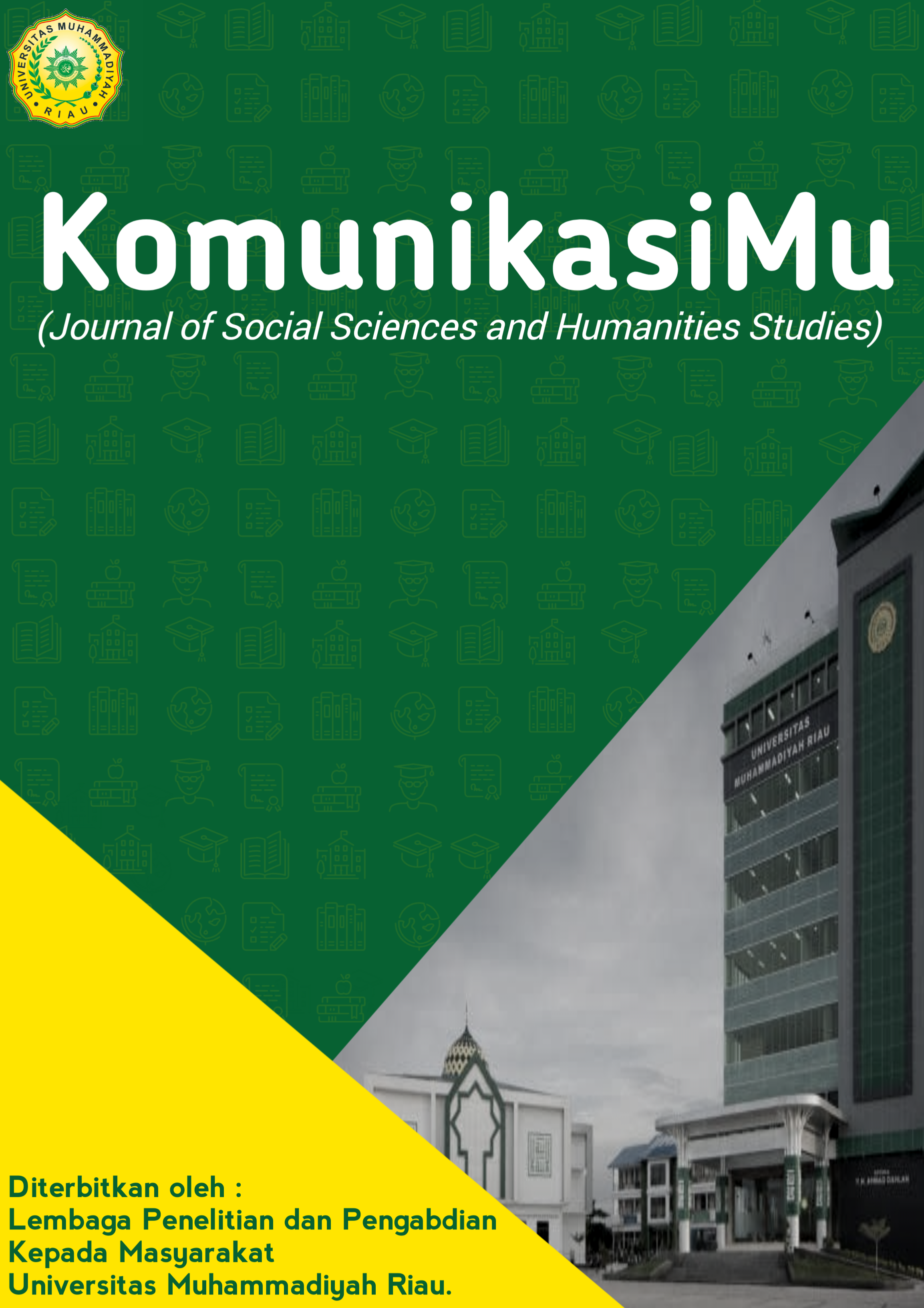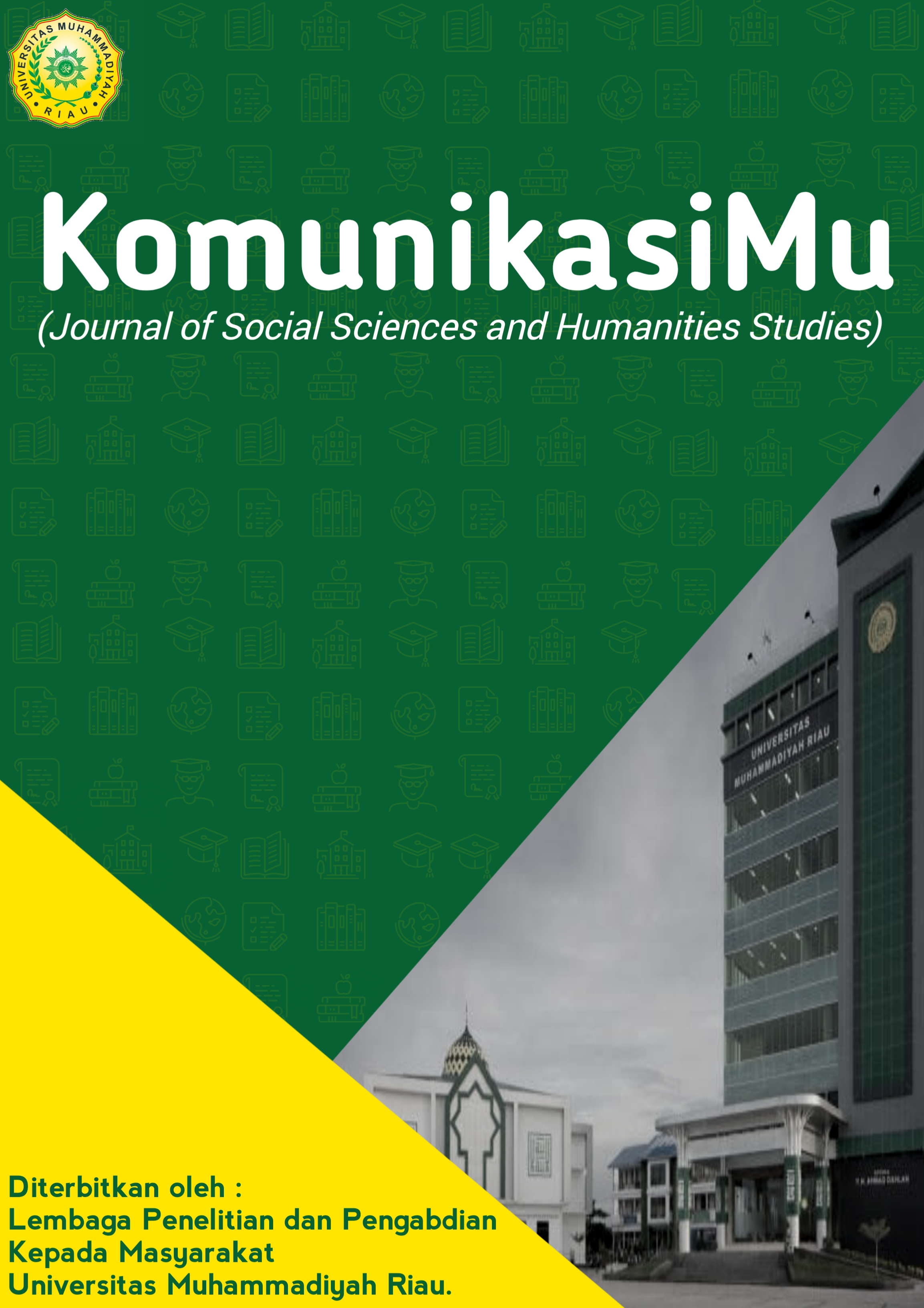-
 Komunikasi Politik dan Branding Melalui Media Sosial DPD Partai Demokrat Provinsi Riau
Vol 2 No 2 (2022)
Komunikasi Politik dan Branding Melalui Media Sosial DPD Partai Demokrat Provinsi Riau
Vol 2 No 2 (2022)Jupendri
Abstract: This article is the result of a study that describes the strategy of the Democratic Party in Riau Province to carry out political communication and party branding through the use of social media. What types of social media do you use? and what kind of political message or content is presented and is considered attractive to the public. The theory used is a hypodermic needle with a descriptive qualitative approach. The result is that the DPD of the Democratic Party of Riau Province carries out political communication and party branding by utilizing the use of social media including Instagram, Facebook, Twitter, Youtube and Tik Tok. Determining the use of social media by taking into account the level of use in the community, voter mapping and social media used on national issues. Political messages contained in the form of content that is interesting and persuasive, informative and critical of local government policies in particular. The content presented is built based on efforts to campaign for the vision and mission of the Democratic party
Referensi
Arrianie, Lely (2010), Komunikasi Politik, Bandung: Widya PadjajaranCangara, Hafied (2009), Komunikasi Politik: Konsep, Teori dan Strategi, Jakarta: PT. Raja Grafindo Persada
Nair, Mc, Brian (2015), Pengantar Komunikasi Politik, Terjemahan Imam Muttaqien,Bandung: Nusa Media
Nimmo, Dan (2005), Komunikasi Politik; Komunikator, Pesan dan Media, Bandung: PT.Remaja Rosdakarya
Susanto, Harry Eko (2010), Komunikasi Manusia; Esensi dan Aplikasi Dalam Dinamika
Sosial Ekonomi Politik, Jakarta: Mitra Wacana Media
Surbakti, Ramlan (2007), Memahami Ilmu Politik, Jakarta; PT. Gramedia
Pawito (2007), Penelitian Komunikasi Kualitatif, Yogyakarta: LKiS
Hidayati, Rahma Festy (2021), Komunikasi Politik dan Branding Pemimpin Politik Melalui
Media Sosial, Jurnal Lensa Mutiara Komunikasi, Volume 2, Halm 145-161, doi: https://doi.org/10.51544/jlmk.v5i2.2385, diakses pada http://e-journal.sarimutiara.ac.id/index.php/JLMI
Meifilina, Andiwi (2021), Media Sosial sebagai Strategi Komunikasi Politik Partai Golkar dalam Melakukan Pendidikan Politik, Jurnal Komunikasi Nusantara, Volume 3, Nomor 2, 101-110, doi: https://doi.org/10.33366/jkn.v3i2.80, diakses https://jkn.unitri.ac.id/index.php/jkn/article/view/80
Ardha, Berliani (2014), Social Media Sebagai Media Kampanye Partai Politik 2014 Di Indonesia, Jurnal Visi Komunikasi, Volume 13, Nomor 01, Halm:105-120,doi:http://dx.doi.org/10.22441/visikom.v13i1.383, diakses
https://publikasi.mercubuana.ac.id/index.php/viskom/article/view/383
Jupendri (2017), Perceptivity Of Campaign Bg Voters In Unision Elections In The Provinsi of Riau 2015, Proceedings Strengthening Local Communities Facing The Global Era, LPPM Press Lembaga Penelitian dan Pengabdian Masyarakat Universitas Muhammadiyah Jember. Halm.70-84, diakses http://jurnal.unmuhjember.ac.id/index.php/pslcf/article/view/888/704 Ramadhani, Rika (2018), Partai Politik dan Demokrasi, Jurnal Demokrasi & Otonomi Daerah, Volume 16, Nomor 3, Hlm. 165-256,Ratnamulyani, Atikah, Ike dan Maksudi, Iriawan , Beddy (2018), Peran Media Sosial Dalam
Peningkatan Partisipasi Pemilih Pemula Dikalangan Pelajar Di Kabupaten Bogor, Jurnal Ilmu-ilmu Sosial dan Humaniora Volume 20, Nomor 2: 154 - 161 -
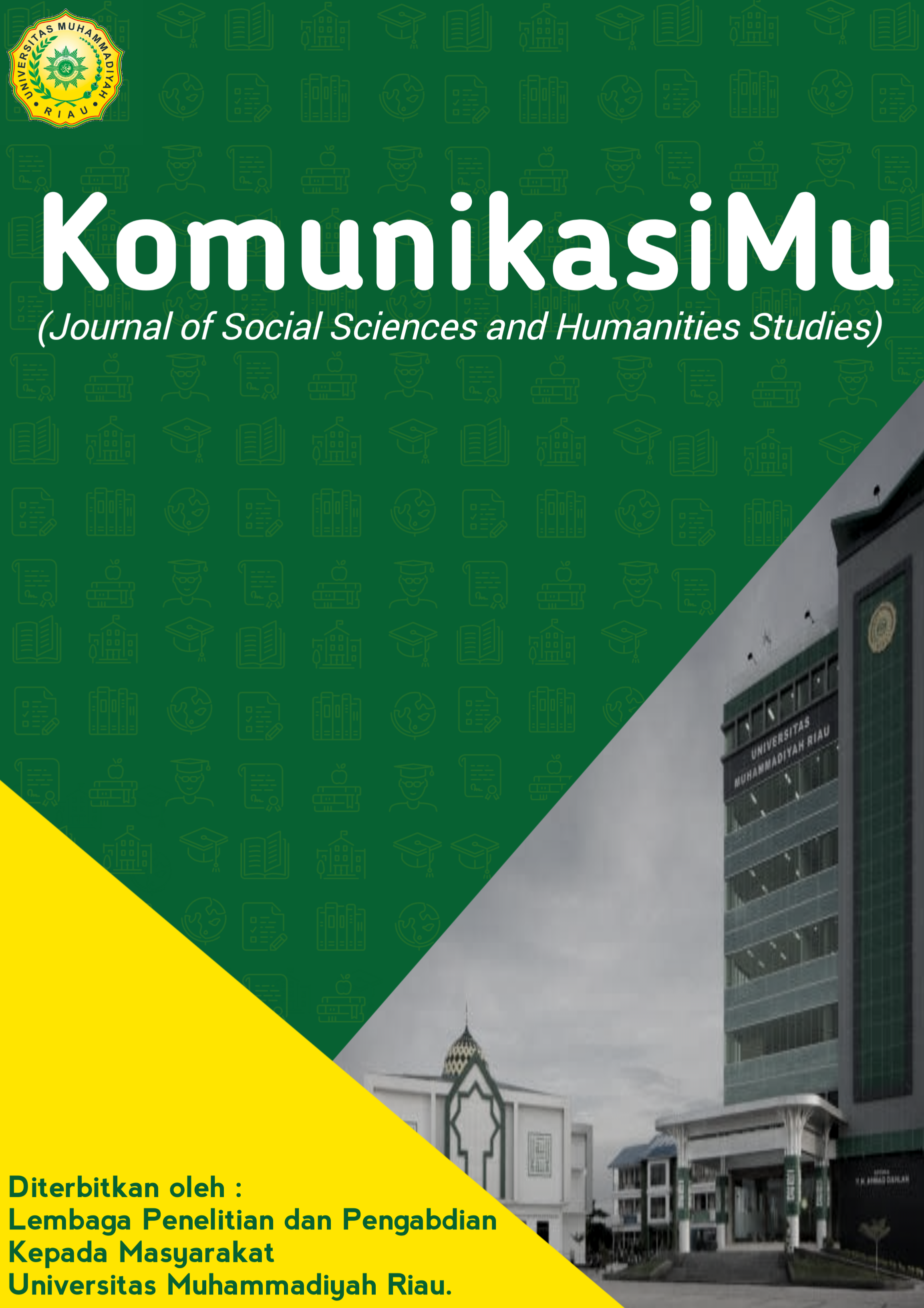 Komunikasi Pemerintahan: Media Komunikasi Digital Melalui E-Government
Vol 2 No 2 (2022)
Komunikasi Pemerintahan: Media Komunikasi Digital Melalui E-Government
Vol 2 No 2 (2022)Komunikasi Pemerintahan: Media Komunikasi Digital Melalui E-Government
Raja Widya Novchi, Eka Putra, Khusnul Hanafi , Raja Arlizon
Abstract:
Government communication is not only a means or a tool for the government to convey and or receive information about a public policy but also as a means of integrating activities in an organized manner in realizing cooperation. The issuance of Presidential Instruction No. 3 of 2003 became the starting point for the implementation of E-Government in Indonesia. The Presidential Instruction emphasizes the importance of utilizing information and communication technology (ICT) in government organizations for effective and efficient governance. E-government is used as a reference used in government information systems (such as in wide area networks, the internet, and mobile communications) which have the ability to bridge relationships with other citizens, business people and various other government elements). The transformative side of e-government is that citizens can directly convey their aspirations to the government without having to be limited by space and time through the websites of various government institutions. The concept of e-government is indeed an effort by the government to facilitate government activities by utilizing advances in information technology.
Keywords:E-Government, Digital Communication, Government Communication
Referensi
Baxter, H. (1987). System And Life-World In Habermas's Theory of Communicative Action. Theory And Society, 16(1), 39-86.
Damanik, M.P & Purwaningsih, E.H. 2017. E-Government dan Aplikasinya Di Lingkungan Pemerintah Daerah (Studi Kasus Kualitas Informasi Website Kabupaten Bengkalis Propinsi Riau). Jurnal Studi Komunikasi Dan Media, 21 (2), 151 – 164.
Dixon, B. E. (2010). Towards E-Government 2.0. Public Administration & Management, 15, 418–454.
Dahlberg, L. 2004. The Habermasian Public Sphere: A Specification Of The Idealized Conditions Of Democratic Communication. Studies In Social And Political Thought, 10, 2-18.
Dahlgren, P. (2005). “The Internet, Public Spheres, And Political Communication: Dispersion And Deliberation.” Political Communication, 147-162.
Habermas, J. (1974). “The Public Sphere: An Encyclopaedia Article.” New German Critique 3, Autum. 49-55
Indrajit, S.E. (2004). Electronic Government (E-Gov) Dan Pengembangan Sistem Pelayanan Publik Berbasis Teknologi Digital).Andi: Yogyakarta
Miles, M. B. & Huberman, A. M. (1984). Qualitative Data Analysis: A Sourcebook Of New Methods. California, SAGE Publications Inc. Media. Penn Fels Institute Of Government, 1–30.
Sosiawan, E. A. (2015). Evaluasi Implementasi E-Government Pada Situs Web Pemerintah Daerah Di Indonesia: Perspektif Content Dan Manajemen. In Prosiding Seminar Nasional Informatika,88–98.
Sugandi, Y.S. (2011). Administrasi Publik, Konsep Dan Perkembangan Di Indonesia.Graha Ilmu: Yogyakarta.
Sutabri, T. (2005). Sistem Informasi Manajemen. Yogyakarta: Andi Offset.
Wright, D. K., & Hinson, M. D. (2015). Examining Social And Emerging Media Use In Public Relations Practice: A Ten-Year Longitudinal Analysis. Public Relations Journal, 9(2), 2–26.
-
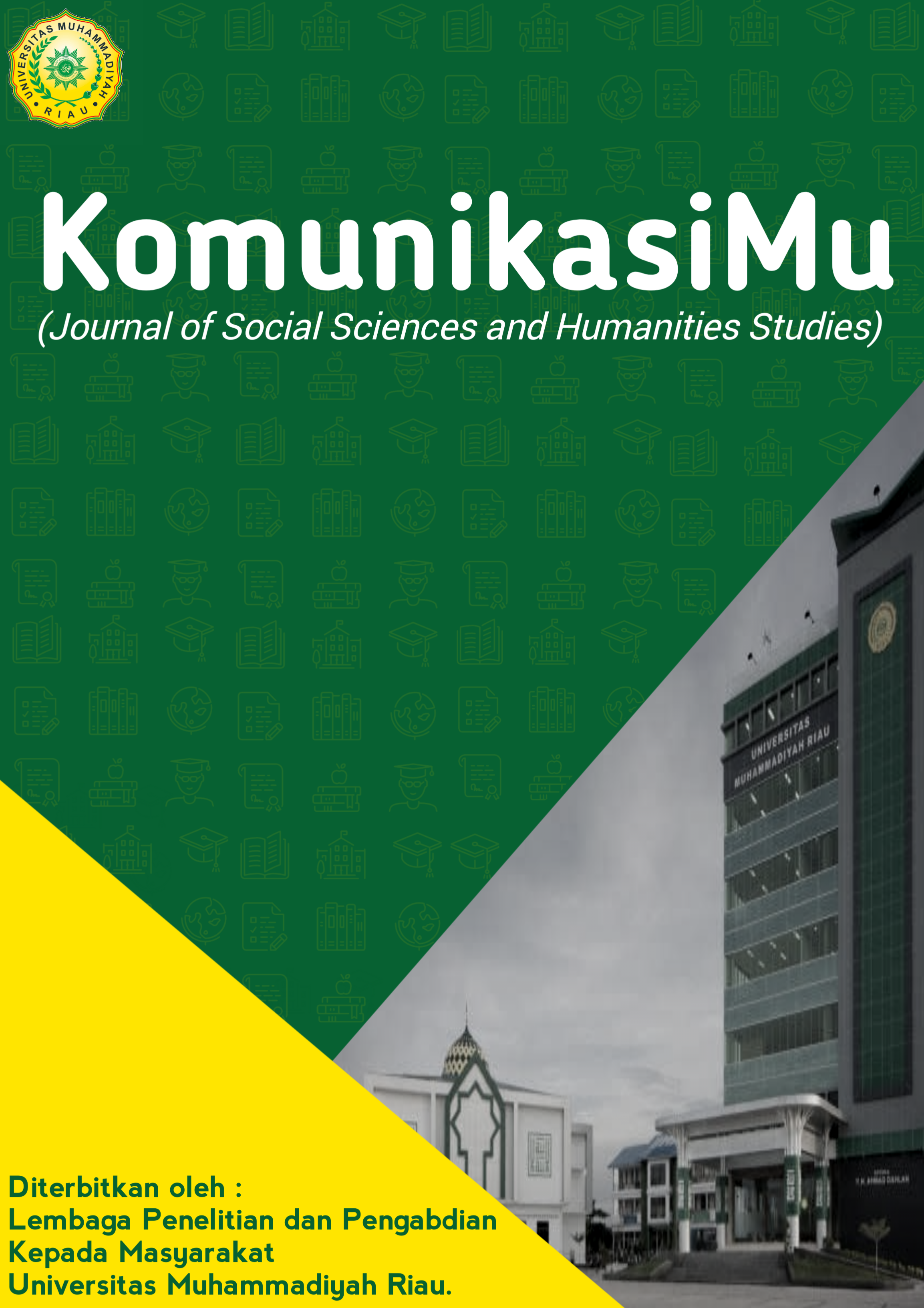 Strategi Komunikasi Pemasaran Go By Sher Dalam Meningkatkan Jumlah Penjualan Merchandise K-Pop Enhypen
Vol 2 No 2 (2022)
Strategi Komunikasi Pemasaran Go By Sher Dalam Meningkatkan Jumlah Penjualan Merchandise K-Pop Enhypen
Vol 2 No 2 (2022)Dini Amelia Gustiani, Ikhma Zurani
Abstract: The high sales of Enhypen merchandise is supported by good marketing from fans (Engene). One form of marketing that is well-known among k-pop is the group order system. The number of group orders is certainly a challenge for group order owners, therefore a good marketing communication strategy is needed when selling k-pop merchandise. One of the group orders that sells Enhypen k-pop merchandise is GO by Sher. This study aims to find out how GO by Sher's marketing communication strategy increases the number of sales of Enhypen k-pop merchandise.This study used descriptive qualitative method. The data obtained were analyzed by reducing the data, presenting the data and drawing conclusions. The marketing communication strategy carried out by GO by Sher in increasing the number of sales of Enhypen k-pop merchandise by using the concept of marketing communication is marketing strategy with social media, word of mouth strategies, the merchandise strategy, and the personal selling strategy.
Keywords: Marketing Communication, K-Pop Merchandise, Strategy
Referensi
Alzikri, N. (2021). Strategi Komunikasi Pemasaran PT. Trio Elektronik Dalam Meningkatkan Penjualan Smartphone Merek Oppo di Kota Pekanbaru. JOM FISIP, 8, 1–15.
Cara Mengatur Pesanan Grup Menggunakan Delivered Korea Layanan Pembelian dan Pengiriman. (2021). Delivered Korea. https://www.delivered.co.kr/id/how-to-organize-a-group-order-using-delivered-koreas-buying-and-shipping-services/ diakses pada tanggal 15 Januari 2022
Charts, E. [@ENHYPEN_Charts]. Charts category where ENHYPEN peaked at #1 on Billboard Japan [Tweet]. Twitter. https://twitter.com/ENHYPEN_Charts/status/1552266579823321088?t=9tZsF1tAJ1ZuzYkGvTbRGw&s=19 diakses pada tanggal 01 Agustus 2022
Ci, S. (2022). Enhypen Jadi Grup K-pop Tercepat yang Menyabet Label Million Seller dengan Dua Album. Yoursay.Id. https://yoursay.suara.com/entertainment/2022/07/12/103703/enhypen-jadi-grup-k-pop-tercepat-yang-menyabet-label-million-seller-dengan-dua-album diakses pada tanggal 01 Agustus 2022
Dwinanda, G., & Nur, Y. (2020). Bauran Pemasaran 7p Dalam Mempengaruhi Keputusan Pembelian Konsumen Pada Industri Retail Giant Ekspres Makassar. Jurnal Mirai Management, 6(1), 120–136. https://www.journal.stieamkop.ac.id/index.php/mirai/article/view/690
Gie. (2020). Sosial Media Marketing: Pengertian, Jenis, Strategi dan Manfaatnya. Accurate. https://accurate.id/marketing-manajemen/sosial-media-marketing-pengertian-jenis-strategi-dan-manfaatnya/ diakses pada tanggal 01 Agustus 2022
Hassan, B.R.A & Novchi, R.W. (2019). Kepeminatan dan Kemodenan dalam Pembentukan Identiti Komuniti Kpopers Pekanbaru. Malaysian Journal of Communication, 35(1), 171-186.
Hardianti, C. (2021). Strategi Komunikasi Pemasaran Amartasalad dalam Menarik Minat Beli Konsumen. Universitas Islam Negeri Sunan Ampel.
Ibnu. (2021). Merchandise Adalah: Pengertian, Jenis Fungsinya untuk Perusahaan. Accurate. https://accurate.id/marketing-manajemen/merchandise-adalah/ diakses pada tanggal 01 Agustus 2022
Indonesia, T. [@TwitterID]. Ada 7,8 miliar Tweet tentang K-pop di dunia di 2021! Berikut ini rangkuman tentang apa dan siapa yang populer di [Tweet]. Twitter. https://twitter.com/TwitterID/status/1486592674622689287 diakses pada tanggal 01 Agustus 2022
Khoiri, A. (2020). Pandemi, Penjualan Album K-Pop Justru Naik 40 Persen. CNN Indonesia. https://www.cnnindonesia.com/hiburan/20200722115853-227-527565/pandemi-penjualan-album-k-pop-justru-naik-40-persen diakses pada tanggal 03 Januari 2022
Niardo, R. (2022). ENHYPEN Pecahkan Rekor Sendiri Dengan Penjualan Mini Album “MANIFESTO : DAY 1” di Hari Pertama. Kpop Chart. https://kpopchart.net/2022/07/enhypen-pecahkan-rekor-sendiri-dengan-penjualan-mini-album-manifesto-day-1-di-hari-pertama.html diakses pada tanggal 01 Agustus 2022
Novchi, R.W., Hanafi, K., Arlizon, R. (2018).The Hallyu in Pekanbaru: An Ethnographic Study on Indonesian Kpopers Parasociality. Conference Proceedings CelSciTech-UMRI 2018.3, 44-53.
Novchi, R.W., Hanafi, K. & Desril, R. (2020). Hallyu di Tanah Melayu (Cultural studies pada korean lovers di Pekanbaru). SOCIAL OPINION: Jurnal Ilmiah Ilmu Komunikasi ,5(2), 151-157.
Purnama, B. (2022). Penjualan Album K-pop Naik 37% pada 2021. Media Indonesia. https://m.mediaindonesia.com/infografis/detail_infografis/465625-penjualan-album-k-pop-naik-37-pada-2021 diakses pada tanggal 12 Juli 2022
Rahman, Y. K. (2020). Strategi Komunikasi Pemasaran Vidio dalam Meningkatkan Minat Beli Akun Premier. Universitas Prof. Dr.Moestopo Jakarta.
Sabila, S. Z. (2020). Strategi Komunikasi Pemasaran Herbalife Dalam Mempertahankan Loyalitas Konsumen Di Pekanbaru. JOM FISIP, 7(1).
Saputra, A. (2014). Strategi Komunikasi Pemasaran Dalam Meningkatkan Jumlah Pengunjung Karaoke Keluarga Inul Vizta. JOM FISIP, 1(2).
Tisra. (2017). Strategi Komunikasi Pemasaran Terpadu (Integrated Maketing Communications) Kaos Dank! Pekanbaru Dalam Meningkatkan Penjualan Produk. Jom Fisip, 4(1), 3.
Zulfandi. (2020). Strategi Komunikasi Pemasaran Event Organizer Sumatera Satu Dalam Mempertahankan Loyalitas Klien Di Pekanbaru. JOM FISIP, 6.
-
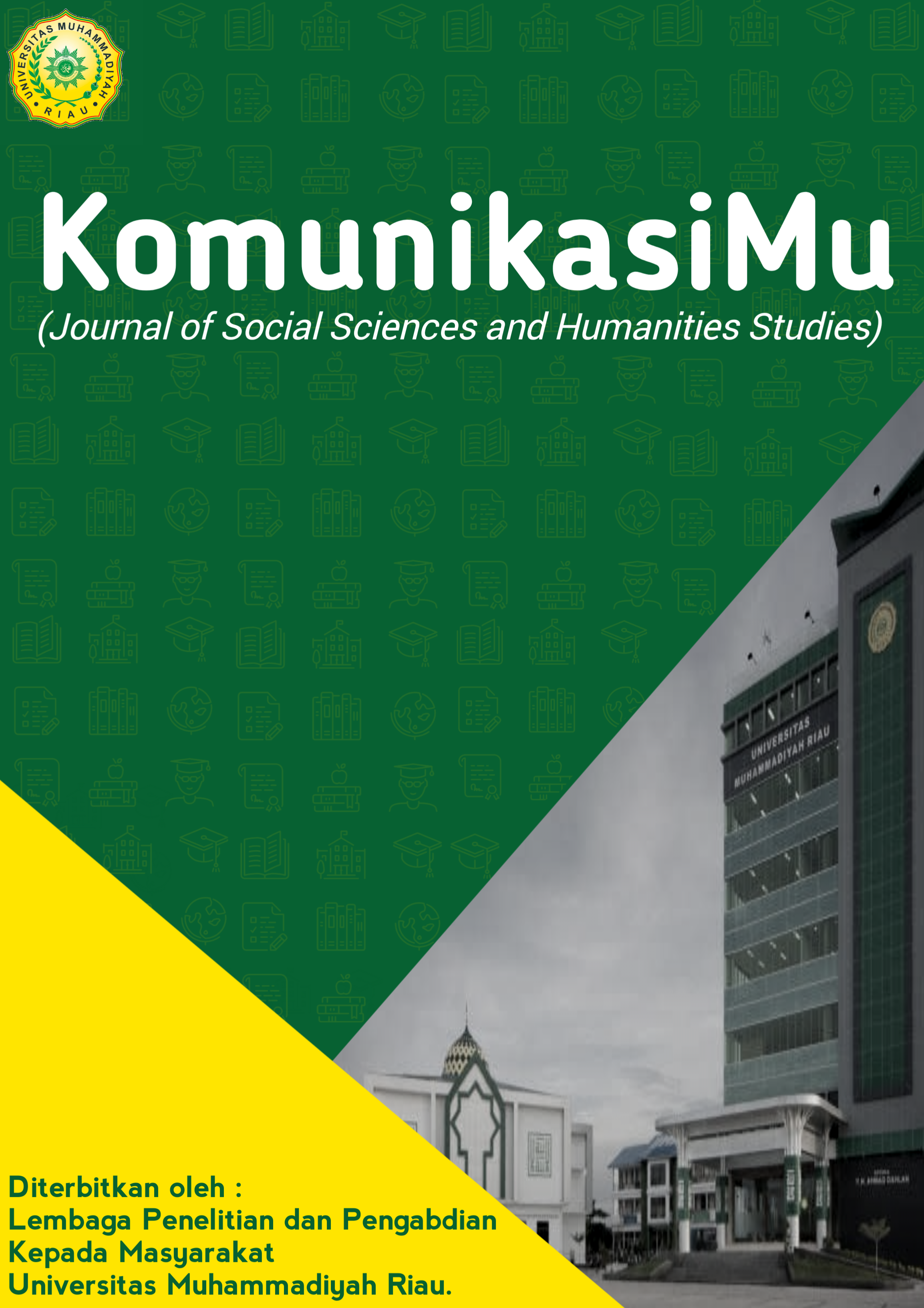 Pengelolaan Kesan Juru Parkir Wanita di Kota Pekanbaru
Vol 2 No 2 (2022)
Pengelolaan Kesan Juru Parkir Wanita di Kota Pekanbaru
Vol 2 No 2 (2022)Abstract:
This study aims to find out how to manage the impression of the front stage and back stage of female parking attendants in Pekabaru. This research uses qualitative research with dramaturgy approach. By using purposive techniques in determining informants. Data collection techniques using interviews, observation, and documentation. The results of this study indicate, when on the front stage the female parking attendant has communication to customers both verbally in the form of greetings, non-verbal can be seen from the signs and attributes used. And at the back stage, the real life of female parking attendants at home and at work is very different, where at work they play a role as parking attendants that are no different from male parking attendants who look strong and tough, but when they are at the parking attendant's house women have strong maternal instincts, it can be seen from their ability to balance between work and as housewives who are responsible for their children.
Referensi
Alwasilah, A. C. 2011. Pokoknya Kualitatif. Jakarta : Pustaka Jaya
Maggie Humm. 2007. Ensiklopedia Feminisme, diterjemahkan oleh Mundi Rahayu, Yogyakarta: Fajar Pustaka Baru,
Sudjatmoko H. 2012. Peraturan Derah kabupaten Purbalingga No 4 Tahun 2012 tentang Penyelenggaraan parkir di tepi jalan umum dan retribusi pelayanan parkir di tepi jalan umum. Bupati Purbalingga. Jawa Tengah : Perda Kabupaten Purbalinggo
Widodo, Suko. 2010. Anatomi dan Perkembangan Teori Sosial. Malang: Aditya Media Publishing.
Yusuf, M. 2017. Metode Penelitian: Kuantitatif ,Kualitatif dan Penelitian Gabungan. Jakarta: Kencana
Zudianto H H. 2009. Peraturan Daerah Kota Yogyakarta No 18 Tahun 2009 Tentang Penyelenggaraan Perparkiran. Walikota Yogyakarta, Yogyakarta: Perda Kota Yogyakarta
Jurnal :
Alim, C. A. 2014. Impression Management Agnes Monica Melalui Akun Instagram (@agnezmo). Jurnal E-Komunikasi, 2(3).
Juditha, C. 2014. Presentasi Diri Dalam Media Sosial Path. Jurnal Penelitian Komuikasi Pembangunan, 15(1).
Berita Online :
https://disdukcapil.pekanbaru.go.id/page/47-data-penduduk-kota-pekanbaru
-
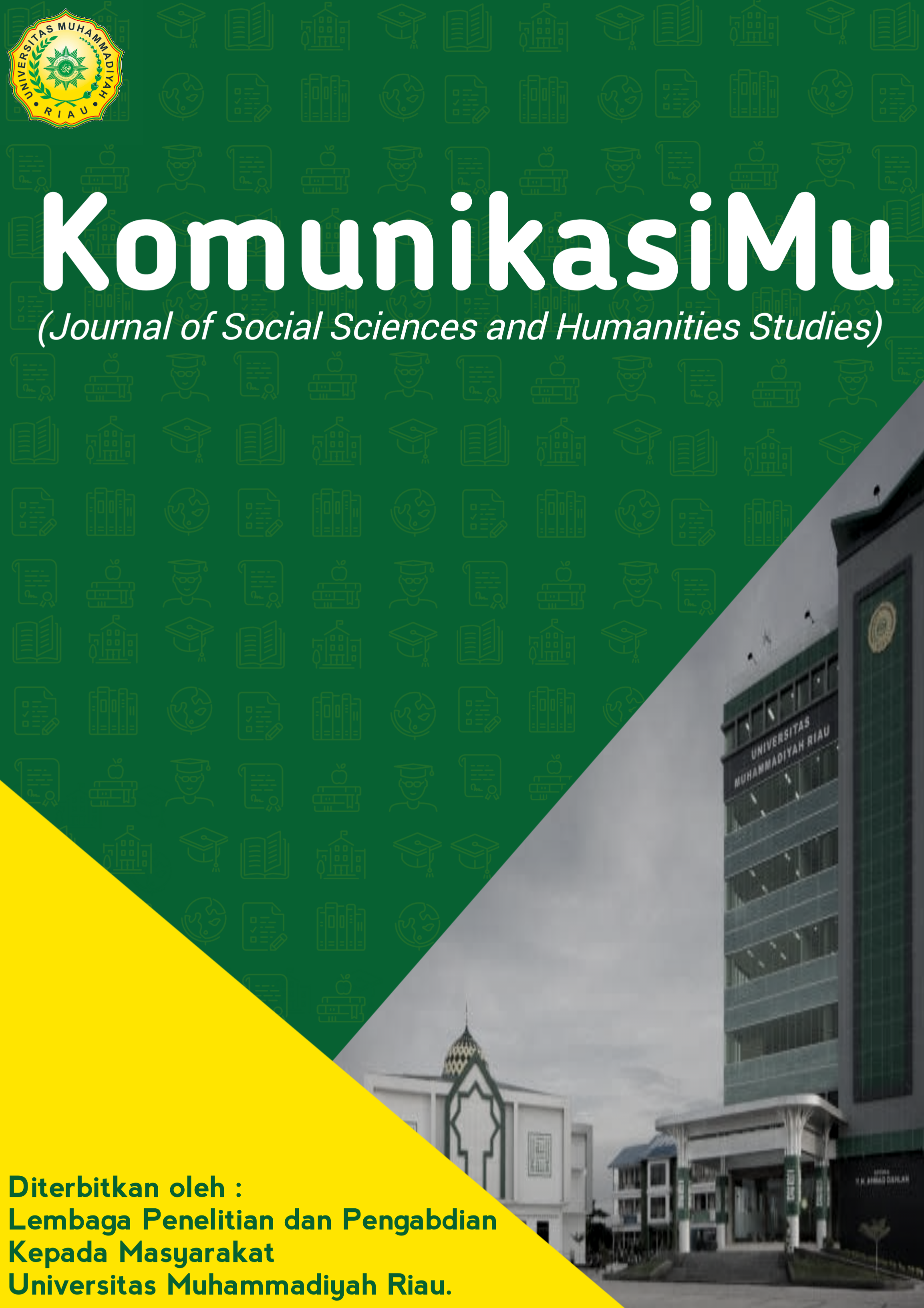 Pengaruh Intensitas Menonton Channel Youtube Edukatif “Cocomelon“ Terhadap Pengenalan Alphabet Pada Anak Usia Dini Di Indonesian Creative School
Vol 2 No 2 (2022)
Pengaruh Intensitas Menonton Channel Youtube Edukatif “Cocomelon“ Terhadap Pengenalan Alphabet Pada Anak Usia Dini Di Indonesian Creative School
Vol 2 No 2 (2022)Abstract: The presence of educational content in the form of audiovisual or video which is very helpful for learning patterns for early childhood. This study aims to measure the effect of watching the Cocomelon Youtube Channel for a long time on the introduction of the early childhood alphabet in the Indonesian Creative School.The distribution of questionnaires and documentation served as the main means of data collection for this quantitative study. At such a young age, 55 participants became respondents in this study who filled out the questionnaire accompanied by their parents. Researchers use SPSS for windows and the application of using linear regression as a strategy. The research leads to the discovery of a new variable, X (intensity of watching) has a small effect on the Y variable (alphabet recognition), which is included in the low category at the coefficient interval of 27.5%.
Keywords :Intensitity’s of watchin; alphabet ; Cocomelon
REFERENSI:
Azwar, S. (2016) .Sikap dan Perilaku.Yogyakarta: Pustaka Pelajar.
Bungin, B. (2011). Metode Penelitian Kuantitatif Komunikasi, Ekonomi Dan Kebijakan Publik Serta Ilmu-Ilmu Sosial Lainnya. Jakarta: Kencana.
Creswell. (2010). Research Desain: Pendekatan Kualitatif, Kuantitatif, dan Mixed (Terjemahan). Yogyakarta: Pustaka Pelajar Morissan. 2013. Teori Komunikasi : Individu Hingga Massa. Jakarta : Kencana.
Kaplan, A. & Haenlein, M. (2010).User Of The World, Unite! The Challenges and Opportunities Of Social Media, Business Horizons.
Rahman, H. S. (2022). Konsep Dasar Pendidikan Anak Usia Dini. Yogyakarta: Galah
Romlah.(2010). Psikologi Pendidikan, Malang: UMM Press.
Sudijono, A. (2015). Pengantar Evaluasi Pendidikan. Jakarta: Rajawali Pers.
Sugiyono. (2014). Metode Penelitian Pendidikan Pendekatan Kuantitatif, Kualitatif, dan R&D. Bandung: Alfabeta.
Sunyoto, D. (2011). Analisis Regresi dan Uji Hipotesis. Yogyakarta: Caps.
- (2021). Pengaruh Konten Vlog Dalam Youtube Terhadap Pembentukan Sikap Sosial Mahasiswa Ilmu Komunikasi Fisip Universitas Islam Kalimantan. Jurnal Ilmu Komunikasi, 4(1), 26–32.
Yamin, M., & Syahrir, S. (2020). Pembangunan Pendidikan Merdeka Belajar (Telaah Metode Pembelajaran). Jurnal Ilmiah Mandala Education, 6(1), 126–136.
-
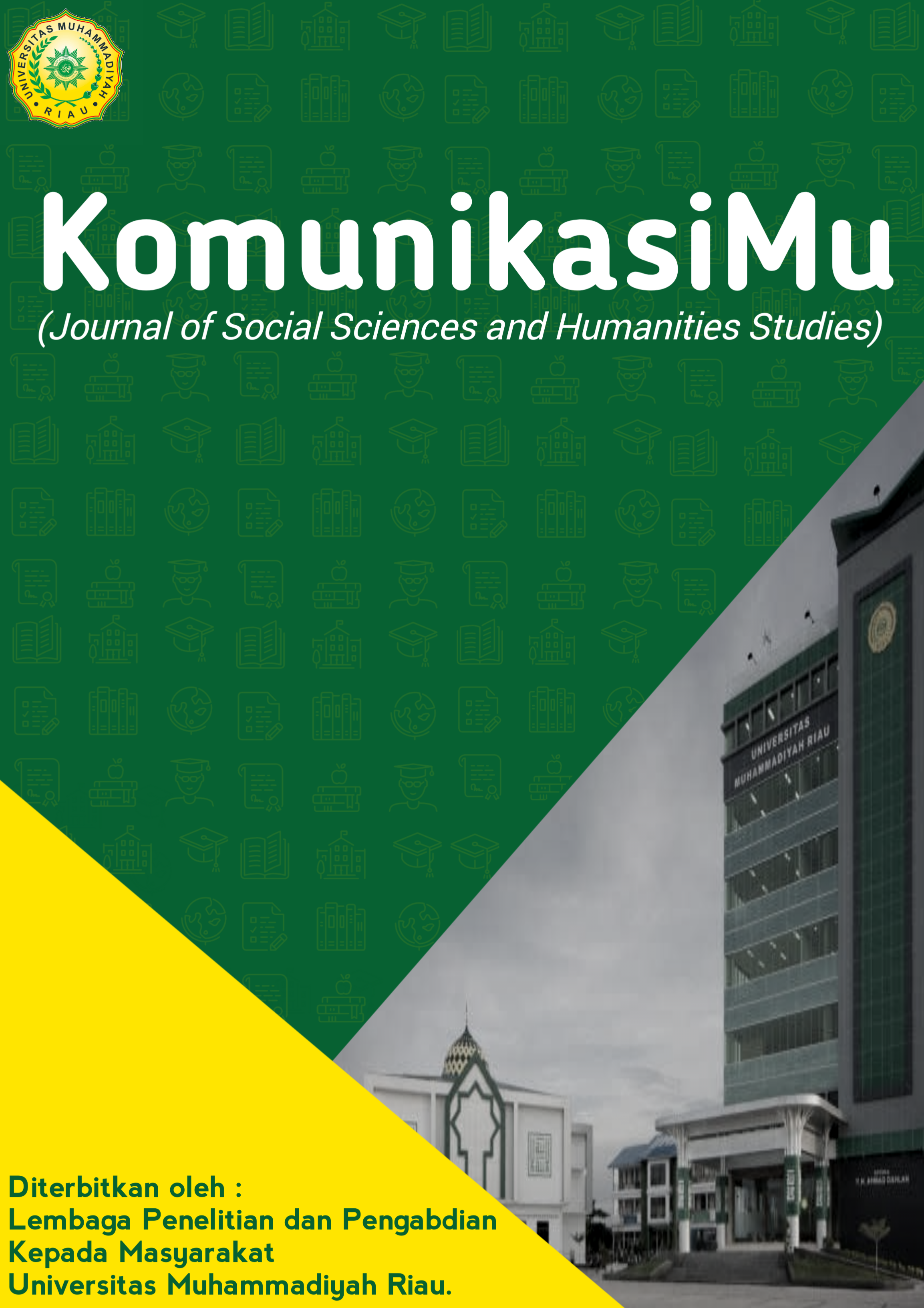 Komunikasi Interpersonal Mediator dalam Proses Mediasi Perkara Perceraian di Pengadilan Agama Pekanbaru
Vol 2 No 2 (2)
Komunikasi Interpersonal Mediator dalam Proses Mediasi Perkara Perceraian di Pengadilan Agama Pekanbaru
Vol 2 No 2 (2)Linda Rahmi, Muhammad Firdaus
Abstract: The purpose of this study was to determine the attitude of openness, empathy, support and positive attitude of the mediator in the mediation process of divorce cases at the Pekanbaru Religious Court. This research used descriptive qualitative method. By using two techniques, namely purposive sampling and accidental sampling. Data collection techniques used are interviews, observation and documentation. The results of this research indicate that the openness shown by the mediator when listening to the litigants tell all their complaints during the mediation process. Openness is also shown by litigants when they consciously and without coercion want to tell the mediator about the problems they are facing based on a sense of trust of the mediator. Empathy is shown by the mediator through changes in facial expressions according to the circumstances of the litigants and does not easily blame the litigants even though sometimes they are indeed guilty.
Referensi
Al-Thofina, M. I. N. (2018). Analisis Yuridis Terhadap Perceraian Pegawai Negeri Sipil Tanpa Izin Atasan (Studi Putusan Nomor: 3957/Pdt.G/2016/Pa.Sda).
Aw, Suranto. (2011). Komunikasi Interpersonal. Yogyakarta: Graha Ilmu
Baron, R. A. dan D. B. (2005). Psikologi Sosial. Erlangga.
Barus, A. S., & Pratiwi, J. M. (2018). Komunikasi Interpersonal Hakim Mediator Dalam Menyelesaikan Perkara Perceraian Di Mahkamah Syari ’ Ah Kota. 7(1), 86–108.
Bungin, B. (2017). Sosiologi Komunikasi: Teori, Paradigma, dan Diskursus Teknologi Komunikasi di Masyarakat. Kencana.
Devito, J. (1997). Komunikasi Antarpribadi Edisi Kelima. Jakarta. Profesional Book.
Mulyana, D. (2018). Ilmu Komunikasi Suatu Pengantar (15th ed.). PT Remaja Rosdakarya.
Luthfi, M., & Rifa’i, M. (2019). Strategi Komunikasi Interpersonal Mediator Bimbingan Masyarakat (BIMAS) Islam dan Pasangan Suami Istri dalam Mencegah Perceraian. SAHAFA Journal of Islamic Comunication, 1(2), 171– 180.
Rahmadi, T. (2011). Mediasi : Penyelesaian Sengketa Melalui Pendekatan Mufakat (2nd ed.). Rajawali Pers.
Rahmi, S. (2021). Komunikasi Interpersonal Dan Hubungannya Dalam Konseling (Pertama). Syiah Kuala University Press.
Sarmiati, E. R. R. (2019). Komunikasi Interpersonal (Pertama).CVIRDH.
Suciati. (2016). Komunikasi Interpersonal Sebuah Tinjauan Psikologis dan Perspektif Islam (Suciati (ed.); Kedua). Buku Litera Yogyakarta.
Supratiknya. 2003. Komunikasi Antarpribadi (Delapan). Kanisius.
West, Richard dan Turner, L. H. (2008). Pengantar Teori Komunikasi Analisis dan Aplikasi (N. Setyaningsih (ed.); Ketiga). Salemba Humanika.
-
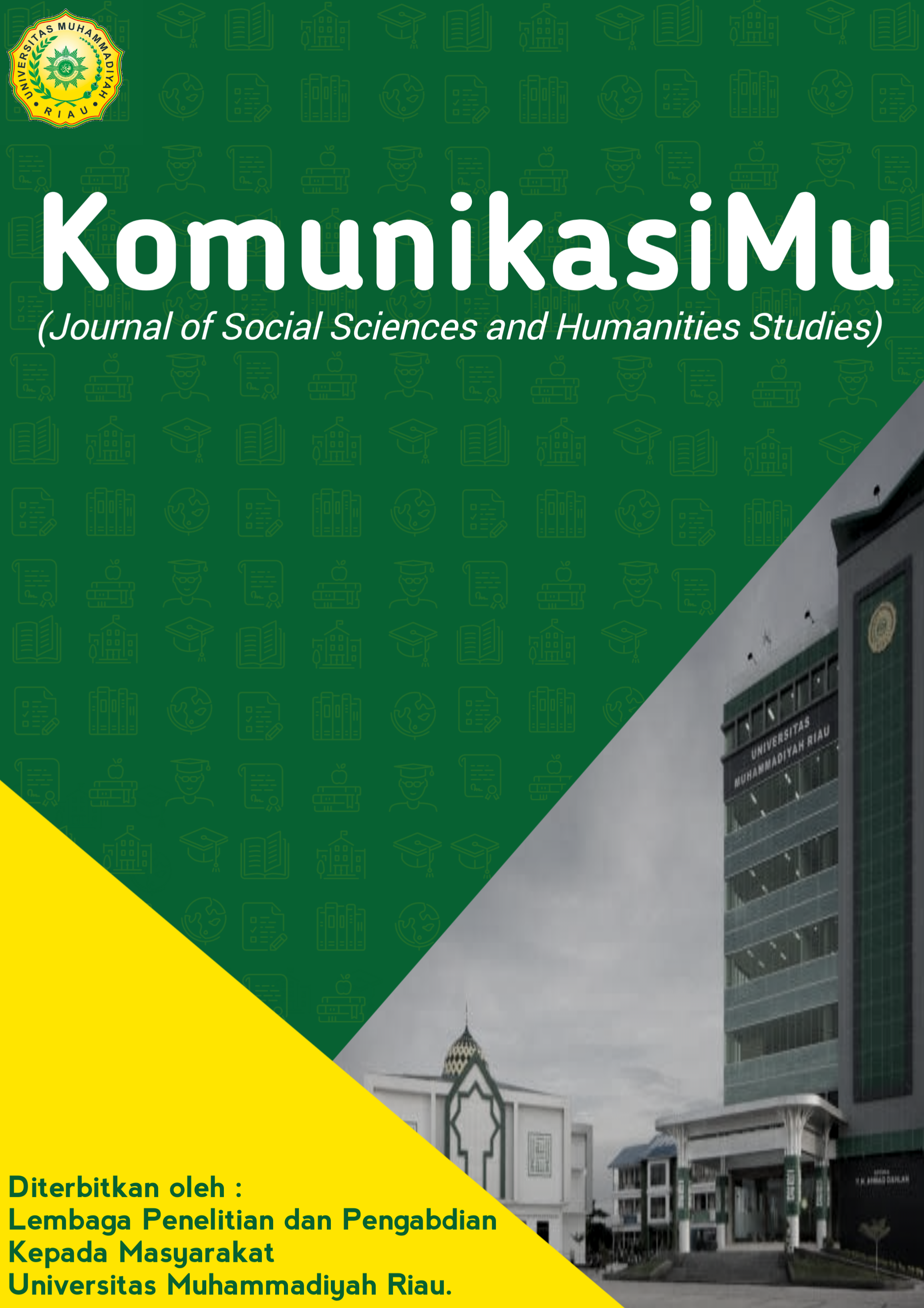 Representasi Penolakan Pembangunan Destinasi Wisata Premium Taman Nasional Komodo Pada Cover Koran Tempo Tahun 2020-2021
Vol 2 No 2 (2)
Representasi Penolakan Pembangunan Destinasi Wisata Premium Taman Nasional Komodo Pada Cover Koran Tempo Tahun 2020-2021
Vol 2 No 2 (2)Ariq Aflah Riadi, Belli Nasution
Abstract: The development of premium tourist destinations in Komodo National Park (TNK) has been controversial. Koran Tempo contains 4 covers related to the project. This study uses the semiotic analysis of Charles Sanders Peirce. The purpose of this research is to find out how Sign, Object, interpretant and representation of rejection of the development of KNP premium tourist destinations are on the cover of the Tempo newspaper for 2020-2021. Using a qualitative approach and research object Tempo newspaper. The research subjects cover the 27th, 28th October 2020 and 4th August 2021 editions. The data collection techniques consisted of observation, interviews and literature study. Data analysis techniques by reducing data, presenting data and drawing conclusions. The validity of the data using triangulation. The results showed that Sign is a cover similar to the Jurassic Park film cover, the red carpet that trucks pass on the back of the Komodo dragon and the UNESCO memorial located at the gate. Objects are text and images on the cover. Interpretant is the interpretation of the reader who sees the 3 covers. The representation is the first cover, through an adaptation of the Jurassic Park film cover as a reference and reference. The second cover, through the use of the red carpet, is an innuendo for the privilege. The third cover, through the use of things related to the Jurassic Park film, such as the word Jurassic Park and a gate.
Keywords: Cover of Tempo newspaper, Representation, semiotic, The development of Komodo National Park
Referensi
Eriyanto. (2011). Pengantar Metodologi untuk Penelitian Ilmu Komunikasi dan Ilmu-Ilmu Sosial Lainnya, Jakarta: Kencana Prenada Media Group.
Fiske, J. (2012). Pengantar Ilmu Komunikasi. Jakarta: PT Raja Grafindo Persada Jampel, I, N,. Sudhita, I, W, R,. & Suartama, I, K,. (2016). Komunikasi Massa. Bali: Universitas Pendidikan Ganesh
Kriyantono, R. (2006). Teknik Praktis Riset Komunikasi. Jakarta: Kencana Rakhmat, Jalaludin & Ibrahim, Idi Subandy. (2017). Metode Penelitian Komunikasi. Bandung: Simbiosa Rekatama Media
Rakhmawati, Y. (2019). Metode Penelitian Komunikasi. Surabaya: CV Putra Media Nusantara
Siyoto, Sandu & Sodik, Ali. (2015). Dasar Metodologi Penelitian. Yogyakarta:Literasi Media Publishing
Sobur, A. (2018). Analisis Teks Media. Bandung: PT Remaja Rosdakarya
Sobur, A. (2003). Semiotika Komunikasi. Bandung: PT Remaja Rosdakarya
Soyomukti, N. (2012). Pengantar Ilmu Komunikasi. Jogjakarta: Ar-Ruzz Media
Sugiyono (2013). Metode Penelitian Kuantitatif, Kualitatif dan R&D. Bandung: Alfabeta
Wibowo, W. S. I. (2013). Semiotika Komunikasi. Jakarta: Mitra Wacana Media
Nata, R. S. (2016). Framing Pemberitaan Sanksi FIFA Terhadap PSSI (Periode 31 Mei 2015 pada SKH Kompas, SKH Republika, SKH Jawa Pos, SKH SINDO, SKH Media Indonesia dan SKH Tempo)
Pranata, H. Y. (2020). Representasi Pria Metroseksual Dalam Iklan Televisi Produk Perawatan Wajah Pria
Priadi, R. (2021). Representasi Janji Jokowi Pada Cover Majalah Tempo Tahun 2019
Satria, A. (2017). Representasi Calon Gubernur DKI Jakarta pada Ilustrasi Sampul Majalah Tempo Tahun 2016-2017
Bornoulli, M. (2015). Pengaruh Teknologi Adopsi Koran Digital (E- Paper) Terhadap Perilaku Penggunaan Dengan Pendekatan UTAUT (Studi pada Harian Umum Pikiran Rakyat). E-proceeding of Management Mahasiswa Universitas Telkom
Dharmayanti dkk. (2017). Representasi Tolak Reklamasi Teluk Benoa Dalam Karikatur Sampul Majalah Bog-bog Cartoon Edisi 2016
Helwati, U. (2014). Konstruksi Publikasi Nilai-nilai Ideologi Dalam Pers (Media Massa). At-Tabsyir, Jurnal Komunikasi Penyiaran Islam STAIN Purwokerto
Mulida, D, S,. Joni, I, D, A, S,. & Pradipta, A, D (2021). Representasi Menuju Penerapan Era Normal Baru Pada Sampel Koran Tempo Edisi 27 Mei 2020. Jurnal Ilmu Komunikasi Universitas Udayana
Praditya, Didit. (2012). Perkembangan Surat Kabar di Era Konvergensi. Jurnal Digitalisasi dan Konvergensi Media Balai Pengkajian dan Pengembangan Komunikasi dan Informatika Bandung
Sudiana, Y. & Muhazir, A,.(2021). Makna Tahun Represi Digital Dalam Cover Koran Tempo Edisi 21 Oktober 2020. Jurnal Ilmu Komunikasi Universitas Amikom Purwokerto
-
 Terpaan Media Sosial Instagram Akun @Pemol.id Terhadap Minat Followers Menggunakan Aplikasi PEMOL (Pemulung Online) Di Kota Pekanbaru
Vol 1 No 1 (2022)
Terpaan Media Sosial Instagram Akun @Pemol.id Terhadap Minat Followers Menggunakan Aplikasi PEMOL (Pemulung Online) Di Kota Pekanbaru
Vol 1 No 1 (2022)Abstract: This study aims to determine how big the influence of social media exposure on Instagram account @Pemol.id on the interest of followers using the Pemol application (Online scavengers) in Pekanbaru City. This study uses an explanative quantitative research method with a simple random sampling technique and uses the Slovin formula to get a total of 100 respondents. The questionnaire is distributed in the form of a google form. The data analysis technique used simple linear regression and coefficient of determination (R²). Researchers analyzed the data using the SPSS for windows version 24 application. Based on the results of a simple linear regression analysis, the coefficient value in this study was Y = 15.333 + 0.741 X. The constant number (a) was 15.333 and the variable coefficient X was 0.741. Meanwhile, the t-count is 11,357 which is bigger than the ttable of 1.664. Where Hₒ is rejected and Hₐ is accepted with a significance of 0.05, it can be said that there is an influence between exposures to social media Instagram @Pemol.id on followers' interest in using the Pemol application (Online Scavengers) in Pekanbaru City is in the medium category.
Keywords: Exposure, Instagram, The Pemol Application.
Referensi:
Buku
Agus, I. (2004). Statistika Konsep Dasar Dan Aplikasinya. Jakarta: Kencana.
Ardianto, dkk. (2014). Komunikasi Massa: Suatu Pengantar. Bandung: Simbiosa Rekatama Media.
Arikunto. (2013). Prosedur Penelitian: Suatu Pendekatan Praktik. Jakarta: Rineka Cipta
Bungin, Burhan. (2006). Sosiologi Komunikasi: Teori, Paradigma dan Diskursus Teknologi Komunikasi di Masyarakat. Jakarta: Kencana.
Effendy, O. U. (2017). Ilmu Komunikasi Teori dan Praktek. Bandung: Remaja Rosdakarya.
Ghozali, I. (2013). Aplikasi Analisi Multivariate Dengan Program IBM SPSS 21. Semarang: Badan Penerbit Universitas Diponogoro.
Ghozali, I. (2018). Aplikasi Analisis Multivariate dengan Program IBM SPSS 25. Semarang: Badan Penerbit Universitas Diponogoro.
Husaini, U. (2006). Pengantar Statistik. Yogyakarta: Bumi Aksara.
Kriyantono, R. (2014). Teknik Praktis Riset Komunikasi. Jakarta: Penerbit Kencana.
Kriyantono, R. (2020). Teknik Praktis Riset Komunikasi Kuantitatif Dan Kualitatif. Jakarta: Penerbit Kencana.
MA, Morissan. (2010). Teori Komunikasi Massa. Bogor: Ghalia Indonesia.
McQuail, D. (2011). Teori Komunikasi Massa. Jakarta: Salemba Humanika.
Mulyana, D. (2014). Ilmu Komunikasi Suatu Pengantar. Bandung: Remaja Rosdakarya.
Nasrullah, R. (2015). Media Sosial. Bandung: Simbiosa Rekatama Media.
Pressman, R, S. (1997). Rekayasa Perangkat Lunak: Pendekatan Praktis (Edisi Satu), Yogyakarta: Andi.
Rasyid, A. (2019). Metode Penelitian Komunikasi. Pekanbaru: UR Press.
Slamet, W. (2017). Pengantar Perilaku Manusia. Jakarta: EGC
Severin, W J., and James W. Tankerd. (2007). Teori-Teori Komunikasi, Sejarah, Metode, Dan Terapan Di Dalam Media Massa. Jakarta: Kencana.
Silalahi, U. (2012). Metode penelitian sosial. Bandung: Refika Aditama
Siregar, S. (2013). Metode Penelitian Kuantitatif. Jakarta: PT. Fajar Interpramata Mandiri.
Sugiyono, (2013). Metode Penelitian Pendidikan Pendekatan Kuantitatif, Kualitatif, dan R&D. Bandung: Alfabeta.
Sunarto R. (2010). Pengantar Statistik. Bandung: Alfabeta.
Zarella, D. (2010). The Social Media Marketing Book. Canada: O’Relly Media. Inc.
Jurnal
Angga, A, M. (2017). Strategi Komunikasi Sales Dalam Memasarkan Mobil Bekas Di Kota Manado (Studi Pada Showroom Mobil Bekas Di Wilayah Kecamatan Malalayang Kota Manado). E-journal “Acta Diurna”, 4(2), 67-68.
Dinda, S, P., & Reni, N. (2019). Pemanfaatan Media Sosial Sebagai Media Promosi (Studi Deskriptif Pada Happy Go Lucky House). Jurnal Common, 3(1), 73.
Herlina, N. (2017). Efektivitas Komunikasi Akun Instagram @Sumbar_rancak Sebagai Media Informasi Online Pariwisata Sumater Barat. Jom Fisip, 4(2), 1–12.
Putri, R, M. (2018). Pengaruh Terpaan Media Pada Akun Instagram @Exploresiak Terhadap Minat Kunjungan Wisata Ke Siak Sri Indrapura. Jom Fisip, 5 (1), 34-36.
Rian, F. (2018). Pemanfaatan Media Sosial Instagram Akun @Vapormxpku Dalam Meningkatkan Promosi Penjualan. Jom Fisip, 5 (11), 122-123
Rizkynata, A, S., Suharyono, & Rizal, A. (2017). Pengaruh Terpaan Media Sosial Instagram Dan Perceived Value Terhadap Keputusan Pembelian (Survei Pada Followers Aktif Akun Instagram Vans Indonesia Yang Menggunakan Sepatu Merek Vans). Jurnal Administarsi Bisnis, 50 (2), 90.
Rouzatul, I., & Anisah, N. (2017). Pengaruh Price Discount Framing Terhadap Keputusan Wanita Membeli Produk Pakaian Wanita di Suzuyu Mall, Setui Benda Acah. JIM (Jurnal Ilmiah Mahasiswa FISIP Unsyia,, 2 (2), 57-58.
Rustono, F, Marta., & Denise, M, W. (2016). Studi Terpaan Media Pemasaran Melalui Posting Instagram Terhadap Ekuitas Merek Pelanggan Sumoboo! (Analisis Eksplanatif Pada Komunitas Food Blogger #Wtfoodies). Jurnal Komunikasi, 8 (1), 69-70.
Shindy, J. (2021). Pengaruh Terpaan Akun Instagram @Zerowaste.Id_Official Dalam Mengampanyekan Gaya Hidup Nol Sampah Terhadap Sikap Ramah Lingkungan Followers. Jom Fisip, 8 (1). 4-5
Setyo F, W. 2015. Pengaruh Persepsi Manfaat, Persepsi Kemudahan, Fitur Layanan, Dan Kepercayaan Terhadap Minat Menggunakan E-Money Card (Studi Pada Pengguna Jasa Commuterline Di Jakarta). Jurnal Riset Manajeman Sains Indonesia, 6 (1): 445
Skripsi
Akhmad, F. (2018). Faktor-Faktor Yang Mempengaruhi Minat Menggunakan Mobile Banking Pada Mahasiswa Universitas Muhammadiyah Surakarta. Program Studi Akuntansi Fakultas Ekonomi Dan Bisnis Universitas Muhammadiyah Surakarta. https://eprints.umc.ac.id/62071/11/Naskah%20Publikasi-2.pdf
Oktavia, D. (2019). Pengaruh Motif Penggunaan Media Sosial Instagram @Sudutpayuhkumbuh Terhadap Kepuasan Followers Dalam Memperoleh Informasi Di Kota Peyukumbuh. Jurusan Ilmu Komunikasi. Universitas Riau Pekanbaru.
Salsabila, A. 2019. Pengaruh Terpaan Pemberitaan Terorisme Di Media Online Terhadap Persepsi Mahasiswa Pada Pakaian Syar’i. Jurusan Jurnalistik. Fakultas Dakwah Dan Ilmu Komunikasi. Universitas Negeri Syarif Hidayatullah Jakarta.
http://www.repository.uinjkt.ac.id/dspace/bitstream/123456789/49440/1/SALSABILA/%20%20AZHAR-FDK.pdf
Vany F.S. 2016. Pengaruh Media Humas Tribratanews Riau Terhadap Citra Polda Riau. Program studi Ilmu Komunikasi Fakulas Dakwah dan Ilmu Komunikasi Universitas Islam Negeri Sultan Syarif Kasim Riau.
Website:
https://Pemol.id di akses pada tanggal 10 September 2021
https://tdbangarna.com diakses pada tanggal 7 Maret 2022
https://andi.link/hootsuie-we-are-social-indonesia-digital-report-2021/ Diakses pada tanggal 18 November 2021.
-
 Strategi Komunikasi Dosen dalam Menerapkan Pembelajaran Daring pada Mahasiswa Saat Pandemi Covid-19
Vol 2 No 2 (2022)
Strategi Komunikasi Dosen dalam Menerapkan Pembelajaran Daring pada Mahasiswa Saat Pandemi Covid-19
Vol 2 No 2 (2022)Anita Pronika, Hari Jummaulana
Komunikasi berasal dari Bahasa latin yaitu communis dimana artinya sama. Komunikasi dapat terjadi jika ada
kesamaan antara orang yang menerima pesan dan kesamaan penyampaian pesan itu sendiri. Secara umum,
komunikasi manusia dapat digambarkan dalam bentuk bahasa isyarat, ucapan, tulisan, gerakan, penyiaran serta dapat berupa interaktif, transaktif, terarah, hingga tanpa tujuan. Dengan melakukan komunikasi, perasaan seseorang maupun kelompok dapat di pahami oleh pihak lain termasuk memahami sikap. Tujuan komunikasi adalah mengubah sikap, pendapat, perilaku, dan sosial. Dimana pada hakikatnya, bentuk komunikasi memiliki tujuan menyampaikan informasi agar dapat dipahami oleh komunikan. Pandemi Covid-19 membawa perubahan yang signifikan dalam segala aspek kehidupan tidak terkecuali dari sektor Pendidikan. Terjadinya pembatasan jarak dilakukan guna menekan penyebaran virus menjadi alasan utama dilaksanakannya perkuliahan daring. Dengan perubahan ini membuat dosen harus menyesuaikan metode pembelajaran dengan menggunakan daring agar proses perkuliahan dapat berjalan dengan baik di masa pandemi covid-19. Konsep utama yang digunakan kepada mahasiswa adalah media baru, komunikasi Pendidikan, strategi komunikasi dan sistem pembelajaran jarak jauh. Konsep utama yang digunakan adalah strategi komunikasi, media baru, komunikasi pendidikan, dan pembelajaran jarak jauh. Dosen sebagai pendidik, menghadapi pendemi covid-19, harus memiliki strategi pembelajaran online yang tepat, agarpengajaran terhadap mahasiswa dapat tersampaikan dengan efektif.Referensi
D. Mulyana, “Pengantar Ilmu Komunikasi”. Bandung: PT.Remaja Rosdakarya, 2013.
D. Stoner, J.A., Freeman, R. E., dan Gilbert, “Managemen”t. New Jersey: Englewood
Cliffs: Prentice-Hall Inc., 1995.
“Hak dan Kewajiban Dosen”. lldikti13kemdikbud.co.id.
Husamah, :Belajar dan Pembelajaran”. Malang: UMM Press, 2018.
T. P. Widianti dkk, “Pembelajaran Daring Masa Pandemi Covid-19 Di Sekolah
Indonesia Kuala Lumpur,‖ J. Pendidik. Islam, vol. Vol. 18. N, pp. 17–31, 2021.
Yuliana, “Coronavirus Disease (COVID-19): Sebuah Tinjauan Literatur”. Wellness
Heal. Mag., vol. vol 2 no.1, pp. 187–192, 2020.
M. Syamsudin, Metode Kuantitatif Komunikasi”.Yogyakarta: Pustaka Pelajar, 2013.
APPI. 2010. “Rekomendasi Peran Pendidikan dalam Pembangunan Karakter Bangsa.
Konferensi dan Workshop tentang Peran Pendidikan dalam Pembangunan
Karakter Bangsa”. Pada 16—17 Oktober 2010 di Universitas Negeri Malang
(UM).
Depdiknas. 2005. ―Undang-undang Guru dan Dosen”. Bandung: Adicita Karya Nusa.
Depdiknas. 2007. ―Pedoman Penilaian Guru dalam Jabatan”. Jakarta: Direktorat
Peningkatan Mutu Pendidik dan Tenaga Kependidikan
Depdiknas. 2003. “Undang-undang Sistem Pendidikan Nasional”. Jakarta: Pusat
Dokumentasi Depdiknas
Slamet Yahya. 2006. “Strategi Pendidikan Islam Menghadapi Kemajuan Iptek”. Jurnal
Magister Agama , Vol.11 No.1, hlm.1- 5.
Buchori, Mochtar, 1994. ―Pendidikan dalam Pembangunan”. Jakarta: IKIM
Jabali, Fu’ad, dan Jamhari, 2003. “IAIN & Modernisasi Islam di Indonesia”. Jakarta:
UIN Jakarta Press, 1424 H./2003 M. cet.I.
Hidayatullah, Taufik, 2010. “Islam dan Pendidikan Karakter Paradigma Pendidikan
Living Values Education (Studi Kasus di Sekolah Madania,‖. Jakarta: Sekolah
Pascasarjana Universitas Islam Negeri (UIN) Syarif Hidayatullah Jakarta.
Ismail, Saminan, 2013. “Budaya Sekolah Islam”. Bandung: Rizqi Press, cet. I.
Mastuhu, 2007. “Sistem Pendidikan Nasional”. Ciputat:Lentera Hati, cet. I.
Nata, Abuddin, 2014. “Sosiologi Pendidikan Islam”. Jakarta: RajaGrafindo Persada, cet. I.
Zubaidi, 2011. “Desain Pendidikan Karakter Konsepsi dan Aplikasinya dalam
Lembaga Pendidikan”. Jakarta: Prenada Media, ce. I -
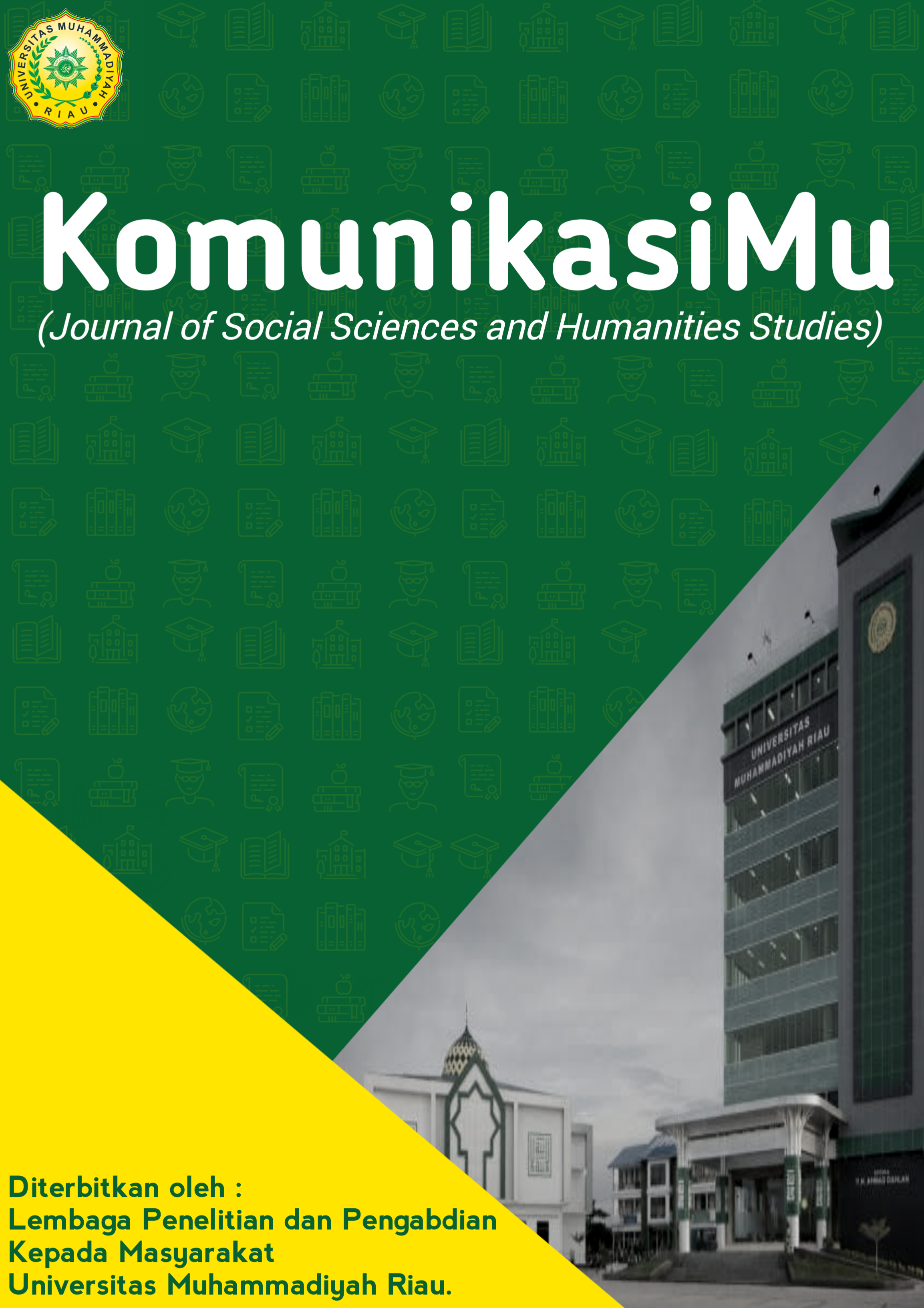 Polarisasi Millennial Trend pada Personal Branding Aktor Politik di Indonesia: Urgensi dan Perkembangannya
Vol 2 No 2 (2022)
Polarisasi Millennial Trend pada Personal Branding Aktor Politik di Indonesia: Urgensi dan Perkembangannya
Vol 2 No 2 (2022)Ulmi Marsya, Johan Faladhin
Abstract: This article discusses the dynamics of the contemporary political world that is always required to be able to keep up with this age. The emergence of new media such as social media that offers an interactive form of communication between political leaders with the wider community. The distribution of messages both text and images presented in new media forms a different political culture among today's political elite. The millennial trend be one of pattern political branding formation on political actor as actualization political persona differentiation. The method used in this article is a literature study, to mapping out the personal branding of political actors. Such as Anies Baswedan, Ganjar Pranowo, Ridwan Kamil, and Sandiaga Uno. The four political actors are actively building values, opinions and communication channels, in using social media as a medium for their interaction with society. There are several millennial criteria what they show is trendy, sporty, humorist, and passionate. But still have not forgotten at the root of the local culture.
Keywords: Millennial Trend, Personal Branding, Political Actor , Political Branding
Referensi
Abidin, S & Cindoswari, A.R. (2019). Political Branding Ridwan Kamil Pada Masa Kampanye Pilgub Jabar 2018 Melalui Twitter. Commed: Jurnal Komunikasi dan Media. 4 (1). 33-48.
Candranegara, I M. W.,Mahardika, I Putu Eka,.& Mitra, I Wayan. (2019). Partisipasi Generasi Milenial di Kancah Politik Nasional. Jurnal Bappeda Litbang. 2 (1), 21-30.
Elya, I & Zulaeha, I. (2017). Model Komunikasi Politik Ridwan Kamil di Media Sosial Instagram. DIALEKTIKA. 4 (2). 205-229.
Heryanto, G.G & Zarkasyi, I. (2012). Public Relations – Politics Communication. Bogor: Ghalia.
Junaidi, R. (2014). Gaya Kepemimpinan Para Tokoh Dunia. Yogyakarta: FlashBooks.
Kurniawan, A. (2014). Komunikasi Visual Personal Branding Soekarno (Sebuah Analisis Semiotika). Jurnal Gelanggang, 1(1), 1-12.
Kurniawan, A.D, Sukriono, Didik, Atok, Rosyid Al. (2021). Pemikiran Politik B.J. Habibie dalam Demokratisasi di Indonesia (B.J. Habibie’s Political Thought in Democratization in Indonesia). Journal of Politics and Policy Volume 3, Number 2, Juni 2021.
Larsson AO & Moe H. (2013). Twitter In Politics and Elections: Insights From Scandinavia, Dalam Bruns A, Burgess J, Weller K, et al. (eds) Twitter and Society. New York: Peter Lang. Publishing, Inc., pp. 319–330.
Lees,M, J. (2014). Political Marketing: Principles and Applications : (2nd Ed.). NY: Routledge. P.178-181.
Macmara, J. (2010). Public Communication Practices in The Web 2.0-3.0 Mediascape: The Case For Prevolution, PRism 7(3): http://www.prismjournal.org.
Mizrawi, Z. (2010). Gus Dur Santri Par Excellnce Teladan Sang Guru Bangsa. Jakarta: Kompas.
Nightingale, V. (2007). Emergence, Search and Social Networking, dalam V. Nightingale & T. Dwyer (Eds.), New Media Worlds: Challenges For Convergence (pp. 291-307), South Melbourne: Oxford University Press.
Parikh, K. A. (2012) Political Fandom in The Age of Social Media: Case Study of Barack Obama’s 2008 Presidential Campaign, London: Media@LSE, London School of Economics and Political Science ("LSE").
Rahardjo, T. (2011) Komunikasi 2.0 :Teoritisasi dan Implikasi. Yogyakarta: ASPIKOM.
Rahmah, S. (2021). Personal Branding Ganjar Pranowo untuk Membangun Komunikasi Politik di Media Sosial Instagram. Jurnal Interaksi: Jurnal Ilmu Komunikasi. 5 (1), 94-101.
Santi, F. Basit, Abdul.,& Muljadi. (2019). Sandiaga Uno’s Personal Branding in the Midst of Indonesian Millenial Generation. Advance in Social Science, Education and Humanities. International Conference of Democratisation in Southeast Asia (ICDeSA): Altantis Press. 263-266.
Shirky, C. (2008). Here Comes Everybody: Revolution Doesn’t Happen When Society Adopts New Technology, It Happens When Society Adopts New Behavior, New York: Allen Lane Pinguin Book.
Solis, B., Dreirdere, Breakenridge. (2009). Putting The Public Back In Public Relations: How Social Media is Reinventing The Aging Business of PR, USA: Pearson Education
Strömbäck, Jesper & Kiousis. (2011). Political Public Relations, Principles and Application’s. New York: Routledge.
Suryawati, I. (2021). Political Branding Gubernur Indonesia Melalui Media Sosial. MEDIALOG: Jurnal Ilmu Komunikasi, 4 (2), 23-38.
Universal, M. (2008). Power To The People Social Media Tracker: Wave 3, New York: Universal McCann.
https://metro.tempo.co/read/1605449/anies-baswedan-45-persen-penonton-formula-e-jakarta-generasi-milenial, diakses pada tanggal 20 Juni 2022
-
 Representasi Kemiskinan dalam Film Parasite Karya Bong Joon-Ho dan Film The White Tiger Karya Ramin Bahrani
Vol 2 No 2 (2022)
Representasi Kemiskinan dalam Film Parasite Karya Bong Joon-Ho dan Film The White Tiger Karya Ramin Bahrani
Vol 2 No 2 (2022)Mitra Yani , Belli Nasution
Abstract: The purpose of this study is to find out the meaning of denotation, connotation and the myth of poverty that is shown in the film Parasite and the film The White Tiger through scene pieces from the two films. The research method used is a qualitative research method with the semiotic analysis technique of Roland Barthes. Data collection techniques used are observation and documentation, with data validity triangulation techniques. The results showed that the scenes in the film Parasite and the film The White Tiger represent structural poverty which is seen directly from the meaning of denotation, connotation and myth. Structural poverty is poverty experienced by a group of people due to the prevailing social structure in the community that does not allow that group to be able to enjoy the sources of income that are actually available to that group. This is also clarified by the Social Democratic Theory, which views poverty as not coming from individual problems but from structural problems.
Keywords: Parasite, Poverty, Semiotics, The White Tiger.
Referensi
Alya, R. (2020). Analisis Semiotika Pesan Moral dalam Film Parasite. Skripsi Sarjana. Medan: Universitas Sumatera Utara.
Angela, M., & Winduwati, S. (2020). Representasi Kemiskinan dalam Film Korea Selatan (Analisis Semiotika Model Saussure pada Film Parasite). Koneksi, 3(2), 478–484.
Baran, S. J. (2012). Pengantar Komunikasi Massa Literasi Media dan Budaya. Jakarta: Salemba Humanika.
Berger, C. R., Roloff, M. E., & Roskos-Ewolsen, D. R. (2015). Handbook Ilmu Komunikasi. Bandung: Nusa Media.
Catelyn, A. (2021). “The White Tiger” Ilustrasikan Satir Berani tentang Sistem Kasta India. ULTIMAGZ.Com. https://ultimagz.com/review/white-tiger-review/
Febrianti, T. (2017). Analisis Perbandingan Konsep Keberfungsian Sosial dalam Pengentasan Kemiskinan Nelayan di Wilayah Pesisir. MIMBAR AGRIBISNIS: Jurnal Pemikiran Masyarakat Ilmiah Berwawasan Agribisnis, 1(1), 71–78.
Feby, F. P. (2021). Kemiskinan Perdesaan di Kabupaten Wonosobo (Studi Kasus di Desa Purwosari Kecamatan Kaliwiro Kabupaten Wonosobo). Journal of Politic and Government Studies, 11(1), 65–80.
Gaol, M. T. L. (2020). Analisis Semiotika Pada Film Parasite dalam Makna Denotasi Konotasi dan Pesan Moral. Skripsi Sarjana. Medan: Universitas Medan Area.
Hall, S. (2012). Representation: Cultural Representations and Signifying Practices. London: SAGE Publishing.
Hamid, H. (2018). Manajemen Pemberdayaan Masyarakat. Makassar: De La Macca.
Ihsani, F. (2020). Gambaran Kemiskinan Di Jepang dalam Film Manbiki Kazoku Karya Hirokazu Kore-Eda. Skripsi Sarjana. Surabaya: Universitas Airlangga.
Latief, R. (2021). Jurnalistik Sinematografi. Jakarta: Kencana.
Nia, F., & Panuju, R. (2018). Representasi Pornografi Dalam Film Jan Dara. Jurnal Komunikatif, 7(2), 210–241.
Ninggolan, M. C. (2012). Analisis Kemiskinan Struktural Masyarakat Petani (Studi Kasus di Dusun Ciaruteun Ilir Desa Ciaruteun Ilir Kecamatan Cibungbulang Kabupaten Bogor). Thesis. Jakarta: Universitas Indonesia.
Nurjanna. (2018). Citra Kemiskinan dalam Novel Ketika Lampu Berwarna Merah Karya Hamsad Rangkuti (Suatu Tinjauan Sosiologi Sastra). Skripsi Sarjana. Makassar: Universitas Negeri Makassar.
Piliang, Y. A. (2018). Hipersemiotika: Tafsir Cultural Studies Atas Matinya Makna. Yogyakarta: Jalasutra.
Pondaag, I. G. U., Akhsaniyah, & Dugis, N. S. (2017). Penindasan Perempuan Dan Alam Dalam Perspektif Ekofeminisme Pada Film “Maleficent.” Jurnal Komunikatif, 6(2), 106–131.
Prasetya, A. B. (2019). Analisis Semiotika Film dan Komunikasi. Malang: Intrans Publishing.
Ramadhanty, J. (2019). Perempuan dan Kemiskinan (Analisis Wacana Model Halliday mengenai Perjuangan Perempuan dalam Film Siti Karya Eddie Cahyono). Skripsi Sarjana. Yogyakarta: Universitas Pembangunan Nasional Veteran Yogyakarta.
Setiaputri, D. A. (2016). Pendidikan di Perbatasan dalam Film “Batas.” KOMUNIKATIF: Jurnal Ilmiah Komunikasi, 5(1), 25–42.
Sobur, A. (2016). Semiotika Komunikasi. Bandung: PT. Remaja Rosdakarya.
Susanti, N. (2017). Representasi Kemiskinan pada Tayangan Reality Show Orang Pinggiran Episode Bakti Suci Andika. Jom FISIP, 4(2), 1–15.
Vera, N. (2014). Semiotika dalam Riset Komunikasi. Bogor: Ghalia Indonesia.
Wahyudi, D. (2021). Sinopsis dan Review Film Netflix The White Tiger (2021). Bacaterus Digital Media. https://bacaterus.com/review-the-white-tiger/
Wibowo, I. S. W. (2013). Semiotika Komunikasi: Aplikasi Praktis bagi Penelitian dan Skripsi Komunikasi. Jakarta: Mitra Wacana Media.
Yoserizal. (2015). Indeks Kemiskinan Manusia. Pekanbaru: Alaf Riau.
-
 Makna Simbolik Tradisi Fanika Era-Era Mbowo dalam Acara Adat Pernikahan Etnik Nias Di Pulau Nias
Vol 1 No 1 (2022)
Makna Simbolik Tradisi Fanika Era-Era Mbowo dalam Acara Adat Pernikahan Etnik Nias Di Pulau Nias
Vol 1 No 1 (2022)Abstract
Fanika era-era mbowo is a tradition Nias ethnic in Nias weddings. The goal is to calculate the dowry, family lineage and clan what cua (grandfather), gawe (grandmother), talifuso cua (grandfather's brother), talifuso gawe (grandmother's brother), talifuso ama (father's brother), talifuso ina (mother's brother), sibaya (uncle), ina sa'a (uncle's wife) and giving advice to the groom. The purpose of this study is to find out the process of implementing the fanika era-era mbowo tradition and how the symbolic meaning of the fanika era-era mbowo tradition in Nias ethnic weddings is. This study uses a qualitative research method with a symbolic interaction theory approach. The object of research from the tradition fanika era-era mbowo, the research subjects consist of five people, namely the traditional head, traditional leaders, brides and the community.Techniques for collecting data are interviews, observations, and documentation. The results showed that the fanika tradition of the mbowo era had several stages, namely mborota mbowo, ngaoto, and mene-mene with stages starting from calling the guest village head and sipangkalan village head to the bride's uncle, followed by the first discussion of mborota mbowo then ngaoto and mene-mene. by using coconut leaves that are cut based on the number of discussions that have been passed. This tradition has a meaning contained in every symbol and interaction used by families who carry out the tradition of the fanika era-era mbowo. The main meaning of this tradition is to introduce who the bride's relatives are to the groom's family.
Keywords:
Fanika Era-era Mbowo, Tradition, Symbolic Meaning, Stages, Nias Ethnic
Referensi:
Ahmadi, D. (2008). Interaksi Simbolik. Jurnal Mediator, 9(2), 301–316.
Agus, H. (2021). Pengantar Ilmu Komunikasi. Bandung: Media Sains Indonesia
Darmawan, Y. (2015). Makna Simbolik Ulos Dalam Pernikahan Adat Istiadat Batak Toba Di Bakara Kecamatan Baktiraja Kabupaten Humbang Hasundutan Provinsi Sumatera Utara. Jurnal Online Mahasiswa (JOM) Fisip, 2,1-10
Fisher, B. Aubrey.(1986). Teori-teori Komunikasi:Perspektif Mekanistis, Psikologis, Interaksional, dan Pragmatis. Penterjemah Soejono Trimo, Penyunting Jalaluddin Rahmat. Bandung: Remaja Rosdakarya.
Haryono, g., Cosmas. (2020).Ragam Metode Penelitian Kualitatif Komunikasi. Jawa Barat: CV Jejak (Jejak Publisher).
Helaludin & Wijaya, H.(2019). Analisis Data Kualitatif: Sebuah Tinjauan Teori & Praktik. Makasar: Sekolah Tinggi Theologia Jaffray.
Kriyantono, R.(2011). Teknik Praktis Riset Komunikasi. Jakarta : Kencana
Liliweri, Alo.(2002).Makna Budaya Dalam Komunikasi Antarbudaya. LKiS. Yogyakarta
Moloeng, Lexy J.(2000). Metodelogi Penelitian Kualitatif. Bandung: Remaja Rosdakarya
Mulyana, D.(2007). Ilmu Komunikasi Suatu Pengantar. Bandung : PT. Remaja Rosdakarya.
Mulyana, D. & Jalaluddin, R.(1998). Komunikasi Antarbudaya. Bandung: Remadja Rosdakarya
Nurdin, A.(2020). Teori Komunikasi Interpersonal Disertai Contoh Fenomena Praktis. Jakarta: Prenada Media
Putri, F. D. (2019). Makna Simbolik Upacara Mangongkal Holi Bagi Masyarakat Batak Toba Di Desa Simanindo Kecamatan Simanindo Kabupaten Samosir Provinsi Sumatera Utara. 2(2), 1–15.
Ritzer, G.(2007). Sosiologi Ilmu Pengetahuan Berparadigma Ganda. Jakarta: Raja Grafindo Persada.
Rasyid, A.(2019). Metode Penelitian Komunikasi. Pekanbaru: UR Press
Saputra, R. F. (2019). Makna simbolik tradisi bakayu dan mangampiang di nagari batipuah ateh kecamatan batipuah kabupaten tanah datar provinsi sumatra barat. Jom Fisip, 6, 1–1
Semiawan, C.(2018). Metode Penelitian Kualitatif. N.p., Grasindo.
Sugiyono. (2010). Metode penelitian kuantitatif kualitatif dan r&d. intro ( PDFDrive ).pdf. In Bandung Alf (p. 143).


